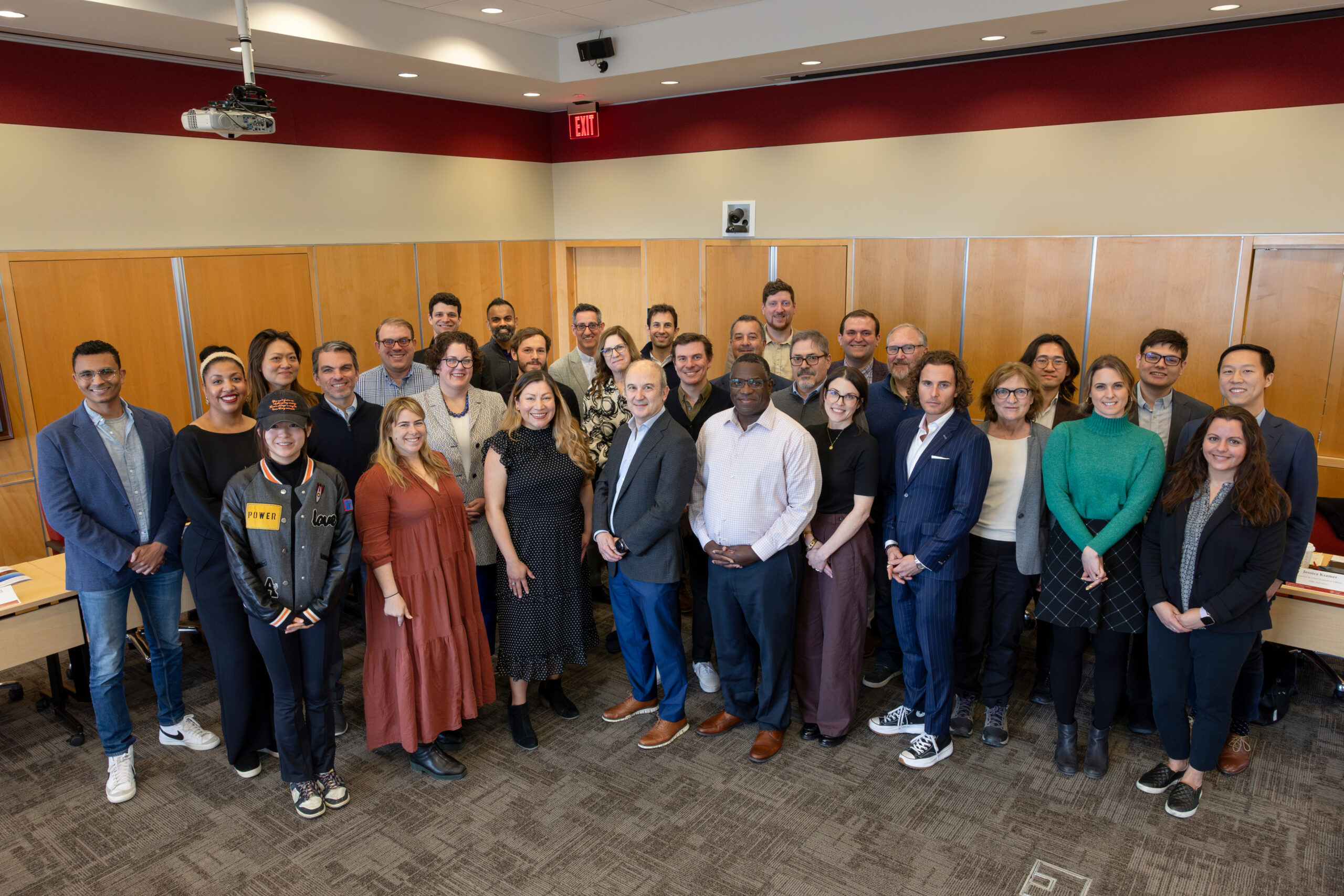The Future of Restaurants

Jason Spillerman '92, P '25, Managing Partner at Vibrant Development Group, Bryan Siegel, Director of Guest Relations and Experience at LDV Hospitality, and Alex Sambvani, CEO of Slang.ai
By Kristen Hawley
How do modern restaurants create community? What strategies actually work for maintaining a robust and responsive loyalty program? Could biases in artificial intelligence change restaurants for the worse?
These are huge questions, and their answers will define the future of restaurants. But the answers aren’t easy. Four years after the most devastating event in history for America’s restaurants — the pandemic — restaurants report operational challenges involving everything from finding, training, and retaining staff to navigating ongoing inflation and operational uncertainty.
On April 10, a group of nearly 30 restaurant industry professionals and Cornell University academics gathered to discuss these challenges and more, talking and thinking through the future of the restaurant industry. The inaugural Restaurant Technology Roundtable: Navigating the Future of Food & Beverage Innovation, was hosted by the Leland C. and Mary M. Pillsbury Institute for Hospitality Entrepreneurship at the Cornell Peter and Stephanie Nolan School of Hotel Administration. Participants talked about technology in the restaurant business, but more importantly, spent several hours discussing hospitality and human connection, underscoring the importance of using good tech to augment, not supplant, a restaurant’s relationship with its customers.

Technology in restaurants today
The good news: Every restaurant can find a tech solution to any one of its problems. Plenty of restaurant technology companies tackle more than one: payments processing, loyalty and customer relationship management, online ordering, inventory management, and (many) more.
The less-good news: Restaurant operators are often forced to choose between point solutions that address one issue and the all-in-one platforms, like a modern point of sale (POS) system meant to do it all.
It’s this dynamic — best-in-class products versus all-in-one convenience — that’s driving many of today’s tech decisions. During the worst days of the pandemic, many restaurants, some hastily, signed technology contracts meant to help boost order volumes, increase customer retention, and better connect with guests. Years later, restaurants are taking stock: are these solutions actually working?
The answer, of course, depends on who you’re asking. Plenty of restaurants embraced pandemic-era trends like online ordering and delivery, collecting scores of data and working to apply it to deepen connections with diners and make better business decisions. But disparate tech products don’t always talk to each other, rendering valuable information less useful than it could be in a fully connected system. Plus, a narrow focus on data from one product — even if it’s best in class — could make it nearly impossible for a restaurant operator to get the full picture.

For example, said Michael Lukianoff, MMH ’00, data science expert and CEO of Extropy360, a restaurant too narrowly focused on its current customer data might miss out on the larger picture, limiting reach and expansion by marketing only inside its own databases.
There are more complicating factors, too. Some of a restaurant’s most important customer-facing technology channels, including third-party delivery and reservations networks, are inherently not all-in-one. Still, they’re powerful demand drivers, critical for restaurants that want a clear picture of evolving customer behavior.
Tomorrow’s restaurant tech
“Community” is the word that most accurately describes the future of restaurants, said Maureen Cushing, chief technology officer at AMP services and co-founder of restaurant technology conference TechTable. We measure our lives in experiences — and restaurants are able to provide some of the best real-life experiences possible. The tech, Cushing said, needs to follow those lines.
Our desire for great experiences extends beyond our visits to restaurants. Employees’ experiences matter, too. Rushi Patel is CEO of scheduling and time-tracking company Homebase, which serves over 2 million employees at small businesses. It recently surveyed workers, who said that flexible work experiences and relationships with co-workers were the most important factors for employees. (Competitive wages came in third.) In the future, Patel said, technology must help create those flexible work experiences, or support whatever else is important to the human employees focused on feeding others at work in restaurants.

The promise of future tech that supports restaurants is also dependent on funding. Private equity and venture capital companies provide investments in new and growing tech companies, often measuring success in terms of size and potential return.
“The tech that’s getting created is there to support the scaled use case,” said Jessica Kramer, founder and CEO at JAK Advisory.
In other words: the mom-and-pop restaurant concept is not investable. That offers opportunity for technology that supports core restaurant functions like digital ordering, payments, and loyalty to keep beloved restaurants in business.
AI: the disruptor
The buzz around artificial intelligence is far, far louder than conversations about utility, but there’s consensus that AI is poised to fundamentally change the restaurant business.
“There is a lot of confusion around AI,” Alex Sambvani, co-founder and CEO of Slang.ai, a company that uses voice AI to answer the phone at restaurants. Sambvani’s team surveyed hundreds of restaurant operators about their use and perception of AI and found that nearly all of them — 94 percent — believe that embracing AI is important to their restaurant’s future. But they seem less sure about how they should use it.
That leaves a lot of room for unintended consequences.
“There are biases, especially as it relates to people getting hired,” said Nicole Allen, MMH ’01, vice president of operations at BenchConnect, which connects hospitality workers with interim and on-call roles. Hiring and human resources software can use AI to determine who gets an interview or even who gets hired, potentially reinforcing certain unequitable behaviors and biases.
AI is a broad term that refers to technology that can automate tasks, solve problems, make decisions, or even create things like images, stories, videos, and recipes. It feels scary, exciting, and sometimes hard to grasp, all at the same time. But plenty of us have strong opinions about its utility, especially in restaurants.

When the new CEO of fast food giant Wendy’s said the chain would implement “dynamic pricing,” using technology to set fluctuating prices based on factors like consumer demand and time of day, customers revolted. Despite comparisons to other industries — hotels and airlines, especially — the idea of changing restaurant prices from a company as well-known as Wendy’s caused serious discomfort.
Existing, evolving, and emerging technology will continue to change restaurants. With great tech in the background, operators can do what they do best: create experiences that serve an engaged community of diners. When high-tech complements high-touch, everyone wins.
“I can definitively say a busy restaurant is way easier to operate than a slow one, and it’s a ten-times better customer experience,” said Johnny Hill ’06, president at New York-based Mediterranean restaurant taïm. “Your structure is set up properly, your dining room is at peak capacity, your operations are set up, you have the appropriate staff. Everything runs very, very fluidly.”

About the author:
Roundtable moderator Kristen Hawley is a freelance journalist and founder of Expedite, a newsletter about restaurant technology and the future of hospitality. Her work has appeared in Fast Company, Insider, Eater, Bon Appetit, Food & Wine, and more. She lives in San Francisco.
